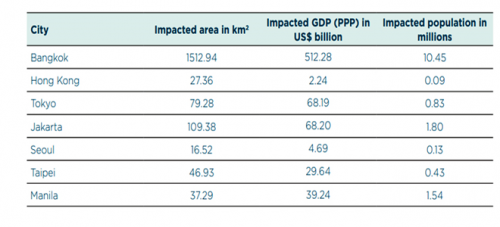As many as 15 million people and 1,829 square kilometers land in seven Asian cities could be affected by extreme sea-level rise and coastal flooding by 2030, a recent report by Greenpeace East Asia flagged.
The report, titled The Projected Economic Impact of Extreme Sea-Level Rise in Seven Asian Cities in 2030, analyzed cities that are economic centers and are located on or close to the coast. The seven cities are: Bangkok, Hong Kong, Tokyo, Jakarta, Seoul, Taipei and Manila.
An estimated $724 billion in gross domestic product (GDP) could be impacted due to extreme sea-level rise and coastal flooding by 2030, according to the report. The estimated GDP impact accounted ranged from 0.4 per cent to 96 per cent of each city’s entire GDP.
Globally, sea levels are estimated to rise 1.1 meter by 2100, if countries are not able to restrict emissions, according to a report by the Intergovernmental Panel on Climate Change (IPCC) on September 25, 2019.
In Asia, coastal cities are at high risk from rising sea levels and intensifying storms. Approximate 600 million people, mostly live in low-lying coastal regions in Asia, are at risk of flooding due to sea level rise.
The researchers used gridded data on extreme sea-level rise, population and GDP to calculate the potential impact of sea-level rise in seven Asian cities. Three datasets: Flooded area by extreme sea-level rise and coastal flooding caused by storm surges and high tides, population density and GDP were used in this analysis.

Major findings of seven Asian cities
- More than 96 per cent of Bangkok’s land area could be flooded in 2030 and could put $512.28 billion of GDP at purchasing power parity and 10.45 million people at risk.
- The analysis projected that in Hong Kong, extreme sea-level riseand any subsequent flooding in 2030 could put $2.24 billion of GDP at purchasing power parity and 90,000 people at risk.
- Extreme sea-level rise and any subsequent flooding in 2030 in Tokyo could put $68.19 billion of GDP at purchasing power parity 0.83 million people at risk.
- Almost 17 per cent of Jakarta’s total land area is below the level to which sea water could rise, leading to GDP risk of $68.20 billion and 1.80 million people at risk.
- Approximately 3 per cent of Seoul’s land area is below the level to which sea water could rise by 2030. The report suggested the affected areas would mainly be residential and agricultural, leading to $4.69 billion of GDP at purchasing power parity risk and put 0.13 million people at risk.
- In Taipei, extreme sea-level rise and any subsequent flooding in 2030 could put $29.64 billion of GDP at purchasing power parity and 0.43 million people at risk.
- Almost 87 per cent of Manila’s land area is below the level to which sea water could rise in 2030. Up to 1.54 million people and a total of $39.24 billion of GDP at purchasing power parity could be affected.
The report did not take into account the effect of levees or seawalls some cities have built or could be building until 2030, which could minimize the flood risk.
The report urged for faster and more ambitious climate action. It urged the governments to commit to achieving ‘net zero’ by 2050.
Mikyoung Kim, climate urgency project manager at Greenpeace East Asia, said:
“Governments must immediately cancel all new coal-fired power plants in the pipeline and speed up the shift to clean and renewable energy. At the same time, the climate emergency is already here, and we need to strengthen disaster management planning and our response to climate impacts. Huge swaths of our cities are at risk of being inundated by floods, and we can’t afford to wait.”
The analysis is one of the first of its kind to use high spatial resolution data to suggest the areas of each city that are at risk from floods.













![[Latest] Global Data Center CPU Market Size/Share Worth USD 48.9 Billion by 2033 at a 15.2% CAGR: Custom Market Insights (Analysis, Outlook, Leaders, Report, Trends, Forecast, Segmentation, Growth, Growth Rate, Value)](https://energy.asia/wp-content/uploads/2024/12/global-data-center-cpu-market-2024-2033-by-billion--120x86.png)




